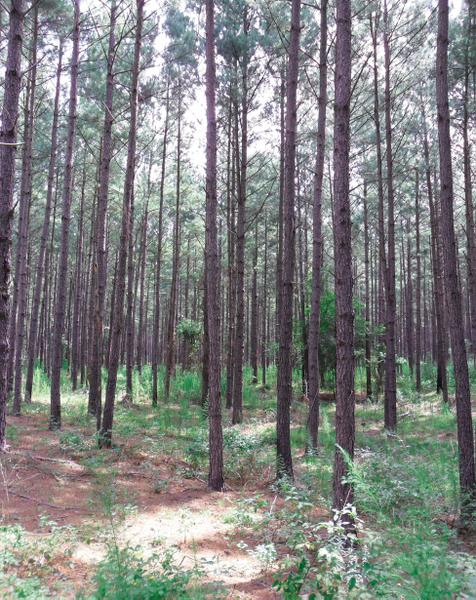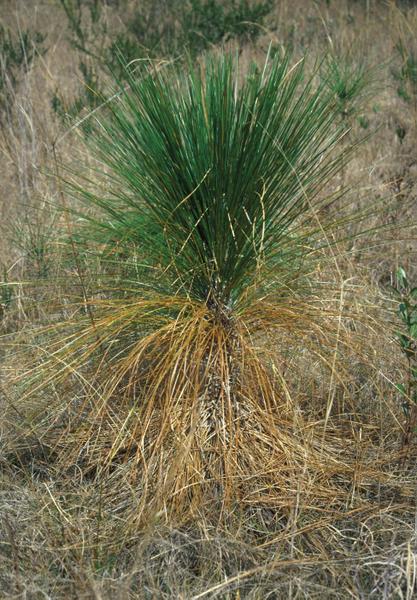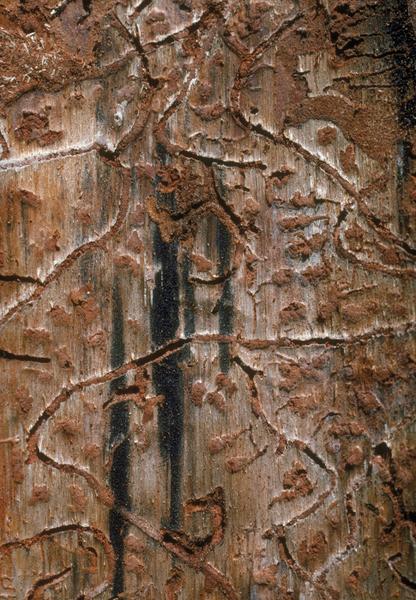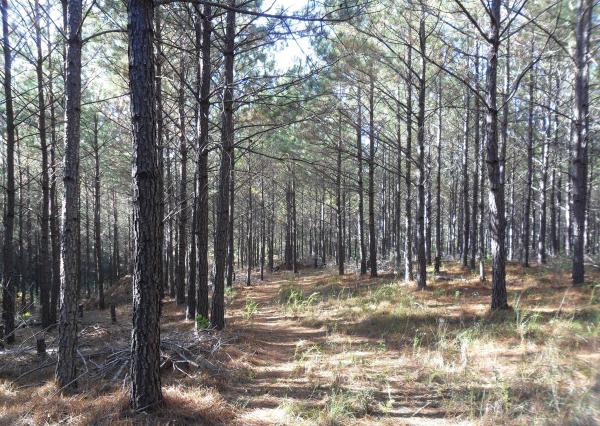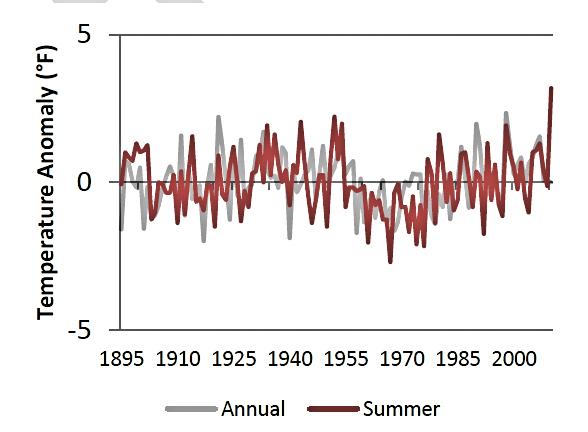What Makes a Healthy Forest?
The southeastern United States has a highly variable climate that includes droughts, floods, tropical systems, thunderstorms, tornadoes, extreme heat, and extreme cold, which affect planted southern pine forests. Though tropical systems bring considerable moisture, they also have the potential to damage limbs and knock down trees. Abnormally wet or dry conditions can cause stress and even mortality. Healthy forests are typically resistant to these kinds of disturbances and can tolerate a range of stressors without significant risk to their conditions.
For example, most pine plantations (like the one shown in Figure 1) can survive a brief dry spell without serious consequences. Healthy forests are also resilient, meaning they will eventually return to their original state even after a severe disturbance causes a short-term change. If that dry spell persists and becomes a major drought, the trees may experience an intense or early loss of needles but will usually recover as conditions improve.
Forest Pests and Diseases
Though trees have adjusted to their local climatic conditions, a forest may require management assistance to remain healthy when facing multiple stresses. Stressed trees experience poor growth, health, and reproduction, as well as an increased risk of disease or pest infestation, such as the brown spot needle disease shown in Figure 2.
Warmer winters have worked to the advantage of many forest pests. Milder winter temperatures fail to control insect and pathogen populations through die-off and increase survival and feeding rates. A longer growing season can lead to larger populations, wider ranges, faster spread, and increased intensity of insect and disease infestations.
Monitoring is crucial to determine the extent of an infestation so managers can act to prevent its spread. Best silvicultural management practices will help ensure healthy forests with good crowns and strong root systems that remain resilient to pests and weather variability.
Highlight: Southern Pine Beetle
The southern pine beetle (SPB) is an insect pest that causes significant economic losses in southern forests. SPBs are small (~1⁄8-inch) brownish-black beetles that come out of dormancy around April. Warmer winters may allow them to become active even sooner. SPBs are aggressive borers, creating S-shaped galleries that can kill pines by girdling them (see Figure 3). They also transmit a blue-stain fungus that plugs tissue and lowers timber value. Plugged tissue can decrease water and nutrient flow throughout the tree, leading to its eventual death.
Evidence of SPB infestation begins with the yellowing of tree crowns; within two months, infested trees brown completely (see Figure 4). Infested trees can exhibit hundreds of pitch tubes on their outer bark, although during drought periods you may see holes only if stressed trees cannot consistently produce pitch. Many stand characteristics increase susceptibility to SPB infestation, some of which management can avoid.
Stands Vulnerable to SPB
- Older stands
- Dense stands
- Stands of slow-growing trees
- Sites on slopes over 10 percent grade
- Poorly drained, low-lying wet sites
- Stands with prior storm damage
- Stands with diseases already present
- Large blocks of short-leaf, pitch, or loblolly pines
SPB on the Move
Warmer, milder winters have allowed SPB to expand its range (see Figure 5). Decreased precipitation may be assisting SPB movement by inducing water stress in trees, lowering their defenses against insect attacks. Many programs attempt to address the SPB problem. Check with your local Forestry Extension group to find out more.
Managing for Resilient Forests
All forests contain insects—they are a natural part of the ecosystem. Insects become pests when they cause damage resulting in loss of productivity, quality, or quantity for the forest owner. So how does a forest manager prepare for an uncertain future? One of the best ways is to follow, or continue following, good silvicultural practices such as the ones listed in Table 1. Not only do these help improve forest resiliency by increasing pest resistance, they will also increase your future return on investment.
Good silvicultural practices alone will not prevent all insect attacks. To increase resiliency, plant species best suited to each site to minimize stress from unfavorable growth conditions. Managing for a diverse mix of species helps prevent pest and disease spread.
| Practice | Description | Rotation Timing | Cost |
| Select Suitable Seedlings | Purchase and plant seedlings that meet your management objectives. Be sure to select seedling families that are adapted to your site and have the appropriate growth potential, disease resistance, and stem and wood qualities for the markets in your region. | Early | Low |
| Plant at Low Density | Planting trees at a lower density has effects similar to thinning. | Early | Low |
| Diversify | Break up large areas of the same type of tree – this helps prevent the spread of forest pests and diseases. Maintain a diverse mix of species adapted to your local site. | Early or Late | Low |
| Thin | Not only does this reduce moisture stress on target trees, but it also increases the availability of nutrients, water, and light, as well as reducing fuel loads in case of drought (as depicted in Figure 6). | Mid | Low |
| Promote Beneficial Predators | This includes providing habitat, such as leaving snags. A natural predator of SPB, the checkered clerid beetle, inhabits trees previously attacked by SPB. This does not treat current outbreaks, but may lessen future pest impacts. | Mid | Low |
| Harvest Earlier | Older trees are more susceptible to insects and diseases; the longer a tree is in the ground, the greater the opportunity for an extreme event (such as a fire or storm) to harm the tree. If trees are vulnerable to infestation, cut now and replant a healthier, more resilient stand. | Late | Low |
| Retain Soil Cover | Promotes nutrient cycling, reduces runoff and erosion, and enhances percolation. | Always | Low |
| Burn | The benefits of burning greatly outweigh the costs. Prescribed burning increases soil nutrients and removes competition, while managing fuel loads to prevent catastrophic fire. Fire is not recommended in young stands (less than 10 years old). | Mid–Late | Medium |
| Chemically Treat | Spraying chemicals is expensive, time consuming, and technical, but is also one of the best means of treating outbreaks that are already occurring. | Mid–Late | High |
Changing Southern Forests
Despite the severity of recent drought in the southeastern United States, climate reconstructions using tree ring data indicate no long-term regional trend in precipitation and soil moisture over the past millennium. Climate reconstructions also show that the severity and duration of several droughts in the twentieth and early twenty-first centuries are not uncommon in a longer-term context. Since records have been kept, there has been no long-term trend in annual or summer precipitation across the Southeast with the exception of the northern Gulf Coast, where precipitation has increased. However, extreme precipitation has occurred more frequently in the Southeast over the past 100 years, especially across the lower Mississippi River Valley and along the northern Gulf Coast. During the past several decades, much of the region has experienced a larger number of very wet and very dry summers compared to mid-twentieth-century summers (see Figure 7). Extremely wet or dry conditions can stress and kill trees.
Although no long-term trend in surface temperature in the Southeast can be found during the past 100 years, the frequency of maximum temperatures above 95°F has been decreasing across much of the region since the early twentieth century, especially in the lower Mississippi River Valley. However, the frequency of minimum temperatures above 75°F has been increasing across the majority of the Southeast. The number of days with extreme cold temperatures has decreased across much of the region. Gradual temperature increases generally increase tree growth by extending the growing season, but extreme hot and cold events can seriously damage trees if they exceed a species’ physiological temperature threshold. (Figure 8 illustrates temperature anomalies in the Southeast.) Heat waves contribute to drought by drying out the soil, while unseasonable cold snaps can kill vulnerable tree seedlings.
The number of major hurricanes (Category 3 or above) and major hurricane landfalls per decade in the Southeast has decreased slightly over the past 100 years. Regardless of the overall trend, tropical systems bring the potential for windfall and broken limbs, as well as crucial autumn rain to maintain soil moisture. Overall, damage and stressed growth due to climate-related impacts and other factors reduce timber revenue. Planting genetic varieties appropriate to the region can help reduce the negative impacts from storm damage and drought stress.
You can proactively manage your forest for health and vigor, and help it to adapt to climate change using many of the same best management practices recommended for fighting SPB. Planting genetically diverse varieties can help prepare a forest for uncertain future climatic conditions and reduce negative impacts from storm damage and drought stress. Thinning and altering rotation length allow managers to adjust to a changing local climate. Prescribed burning can reduce fuel loads and wildfire risk, which are likely to increase in hotter, drier conditions. Controlling invasive species and pests will limit the cumulative stressors impacting your forest, reducing its vulnerability to climate change.

Figure 7. Increasing occurrence of extreme precipitation events over the past century from the National Climatic Data Center. Blue represents long-duration extreme events. Red represents short-duration extreme events.
Image from Draft: Southeast Region Technical Report to the National Climate Assessment
References
Douce, G. K., C. Evans, D.J. Moorhead. “Southern Pine Beetle” – eXtension.
Ingram, K., K. Dow, and L. Carter. (2012). Draft: Southeast Region Technical Report to the National Climate Assessment.
Kolb, T.E., M.R. Wagner, and W.W. Covington. (1995). “Forest Health from Different Perspectives.”
Nebeker, E. “Characteristics of Pine Stands Susceptible to Southern Pine Beetle” – eXtension.
Spittlehouse, David L. and R.B. Stewart. (2003). “Adaptation to Climate Change in Forest Management.” BC Journal of Ecosystems and Management, 4(1), 1-11.
The Pine Integrated Network: Education, Mitigation, and Adaptation project (PINEMAP) is a Coordinated Agriculture Project funded by the USDA National Institute of Food and Agriculture.
Publication date: May 10, 2016
Reviewed/Revised: Nov. 24, 2025
AG-772
N.C. Cooperative Extension prohibits discrimination and harassment regardless of age, color, disability, family and marital status, gender identity, national origin, political beliefs, race, religion, sex (including pregnancy), sexual orientation and veteran status.

